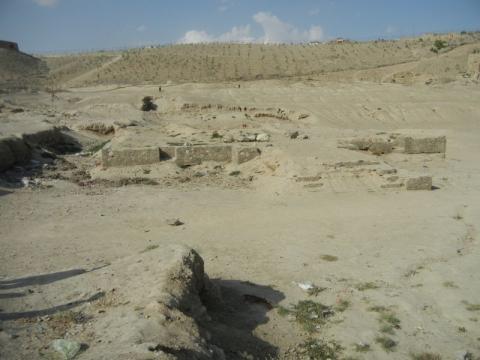Tepe Maranjan is a Buddhist complex rising on a hill of the same name within the current limits of Kabul (Afghanistan).The potential value of this site for the cultural history of the region is unfortunately compromised by insufficient documentation. The only extant record of the excavation of the site, carried out in 1933 by Jean Carl and Joseph Hackin of the Délégation Archéologique Française en Afghanistan (DAFA), consists of two short preliminary reports with inconsistencies between the text and images.
From 1981 to 1987 the Afghan Institute of Archaeology undertook new excavations at the base of the plateau (Tepe Maranjan 2) in the proximity of the old site (Tepe Maranjan 1); these results were also never published. A general description has recently been published by Gerard Fussman based on notes taken during a quick visit to the site. The excavation brought to light a large stūpa (Fig. E), in fact one of the largest in Afghanistan, surrounded by other small stūpas. Four coins collected from the courtyard span from Kanishka I (c. 127/128 – 150/151 CE) to the Kushano-Sasanian or Hunnic period. A small trench dug in the core of the Main Stupa revealed the relic recess containing four reliquaries and seven coins, which Fussman assigns to Azes II (second half of the 1st century BCE). Tepe Maranjan 2 would thus contain additional evidence for the early establishment of Buddhist settlements in Afghanistan, possibly at the time of Azes II or shortly thereafter. Tepe Maranjan 1 would have represented a new phase, simultaneously marking the restoration of the sacredness of the site following an interlude represented by the construction of a small castle (qal`a) dominating Tepe Maranjan 2. A treasure hidden in the qal`a around 385 CE, which gives a terminus ante quem and post quem for the construction and abandonment of the fort, provides a terminus ante quem non for the construction of Tepe Maranjan 1, which lies to the west of the qal`a and is dated by Fussman to the 6th or 7th century CE.
According to this reconstruction, the two niches along the outer side of the western wall of the qal`a belong to this phase. One of these niches, which was found sealed during excavation, housed the famous Bodhisattva image on display in the Kabul Museum; it is now restored after having been seriously damaged by the Taliban. The end of the new site, which is not securely dated, was preceded by a phase of impoverishment and decay; as observed in other Buddhist sites, damaged sculptural materials were retrieved and deposited in a more protected location.
The relationship between Tepe Maranjan 1 and the “fort” remains, however, a matter of speculation. Contrary to Fussman, the Japanese scholar Shoshin Kuwayama holds that the qal`a with its niches and the stūpa court belong to the same chronological and functional horizon. The niche might have been sealed for structural reasons, and also the round bastions, which give the structure the appearance of a qal`a, may have been added at the same time as a further reinforcing measure. This would allow a much earlier date for the Bodhisattva image, which would indeed fit better with its strong “Gandharan” features. In this framework, the sealing of the niche with its content might be compared with similar occurrences in other Buddhist sites, for instance at Tapa Sardar (showcase 15), a Buddhist equivalent of the favissae, where in ancient times no longer functional cult objects were ritually buried in a sacred context.

